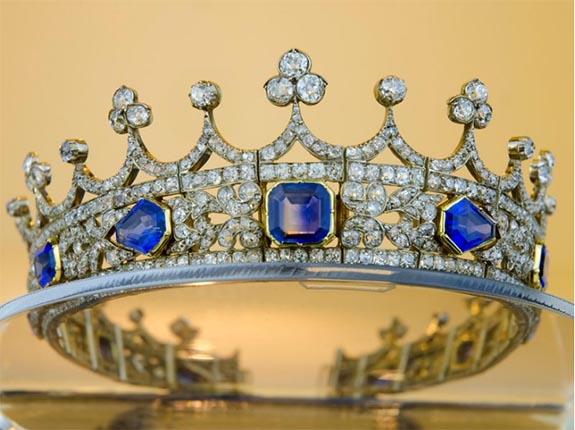September 1st, 2016
Calling it a symbol of one of Britain's most famous love stories, UK officials placed a temporary export ban on the petite sapphire and diamond crown — called a coronet — that Prince Albert gifted to Queen Victoria for their wedding in 1840.

Now in the possession of a private owner, the coronet was scheduled to be auctioned with an asking price of $6.5 million plus $1.3 million in taxes. The owner had applied for an export license in the event that the piece was purchased by a non-Brit.
That move quickly sparked action by government officials who believe the coronet was “key to the self-image of the young Victoria” and should remain on British soil. The export ban, which is valid until December, will give a British collector an opportunity to step forward and make an equivalent bid, or declare an intention to raise the funds.

“Queen Victoria’s coronet is stunning," noted Matt Hancock, the Minister of State responsible for digital policy at the Department for Culture, Media and Sport. "It is one of the most iconic jewels from a pivotal period in our history and symbolizes one of our nation’s most famous love stories. I hope that we are able to keep the coronet in the UK and on display for the public to enjoy for years to come.”
Knowing that the Queen had a passion for colored gemstones, Prince Albert helped design a 4.5-inch-wide crown mounted with 11 large blue sapphires and studded with hundreds of smaller diamonds. He presented the coronet to Queen Victoria as a wedding present, along with a matching brooch. The crown was designed by goldsmith Joseph Kitching and cost £415 ($545) at the time.
Queen Victoria was only 23 years old in 1842 when she posed for an official state portrait wearing the coronet (see above).
After Queen Victoria's death in 1901, the coronet was handed down to Queen Mary (1867-1953) and King George V (1865-1936), who then gifted the piece to Princess Mary on her marriage to Viscount Lascelles in 1922. It was later purchased by a London dealer who sold it to the current owner.
“Its departure would be a great loss, given its beauty, its associations and its history,” Philippa Glanville, a member of the Reviewing Committee on the Export of Works of Art and Objects of Cultural Interest, said in a statement.
Although the export ban extends to December 2016, officials do have the option of extending it through June of 2017 if a UK buyer comes forward and demonstrates the ability to raise the funds needed to buy the piece.
Credits: Coronet image courtesy of the UK Department for Culture, Media and Sport. Official portrait of Queen Victoria wearing the coronet in 1842 by Franz Xaver Winterhalter. [Public domain], via Wikimedia Commons.

Now in the possession of a private owner, the coronet was scheduled to be auctioned with an asking price of $6.5 million plus $1.3 million in taxes. The owner had applied for an export license in the event that the piece was purchased by a non-Brit.
That move quickly sparked action by government officials who believe the coronet was “key to the self-image of the young Victoria” and should remain on British soil. The export ban, which is valid until December, will give a British collector an opportunity to step forward and make an equivalent bid, or declare an intention to raise the funds.

“Queen Victoria’s coronet is stunning," noted Matt Hancock, the Minister of State responsible for digital policy at the Department for Culture, Media and Sport. "It is one of the most iconic jewels from a pivotal period in our history and symbolizes one of our nation’s most famous love stories. I hope that we are able to keep the coronet in the UK and on display for the public to enjoy for years to come.”
Knowing that the Queen had a passion for colored gemstones, Prince Albert helped design a 4.5-inch-wide crown mounted with 11 large blue sapphires and studded with hundreds of smaller diamonds. He presented the coronet to Queen Victoria as a wedding present, along with a matching brooch. The crown was designed by goldsmith Joseph Kitching and cost £415 ($545) at the time.
Queen Victoria was only 23 years old in 1842 when she posed for an official state portrait wearing the coronet (see above).
After Queen Victoria's death in 1901, the coronet was handed down to Queen Mary (1867-1953) and King George V (1865-1936), who then gifted the piece to Princess Mary on her marriage to Viscount Lascelles in 1922. It was later purchased by a London dealer who sold it to the current owner.
“Its departure would be a great loss, given its beauty, its associations and its history,” Philippa Glanville, a member of the Reviewing Committee on the Export of Works of Art and Objects of Cultural Interest, said in a statement.
Although the export ban extends to December 2016, officials do have the option of extending it through June of 2017 if a UK buyer comes forward and demonstrates the ability to raise the funds needed to buy the piece.
Credits: Coronet image courtesy of the UK Department for Culture, Media and Sport. Official portrait of Queen Victoria wearing the coronet in 1842 by Franz Xaver Winterhalter. [Public domain], via Wikimedia Commons.


